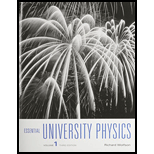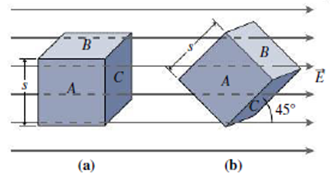
Essential University Physics (3rd Edition)
3rd Edition
ISBN: 9780134202709
Author: Richard Wolfson
Publisher: PEARSON
expand_more
expand_more
format_list_bulleted
Concept explainers
Textbook Question
Chapter 21.2, Problem 21.2GI
The figure shows a cube of side s in a uniform electric field

Expert Solution & Answer
Want to see the full answer?
Check out a sample textbook solution
Students have asked these similar questions
Consider a rubber rod that has been rubbed with fur to give the rod a net negative charge, and a glass rod that has been rubbed with silk to give it a net positive charge. After being charged by contact by the fur and silk...?
a. Both rods have less mass
b. the rubber rod has more mass and the glass rod has less mass
c. both rods have more mass
d. the masses of both rods are unchanged
e. the rubber rod has less mass and the glass rod has mroe mass
8) 9)
10)
11)
12)
13)
14)
15)
Chapter 21 Solutions
Essential University Physics (3rd Edition)
Ch. 21.1 - Which figure represents the electric field of a...Ch. 21.2 - The figure shows a cube of side s in a uniform...Ch. 21.3 - A spherical surface surrounds an isolated positive...Ch. 21.4 - A spherical shell carries charge Q distributed...Ch. 21.5 - (1) If you're close to a finite line of charge...Ch. 21.6 - (1) If you're close to a finite line of charge...Ch. 21 - Can electric field lines ever cross? Why or why...Ch. 21 - The electric flux through a closed surface is...Ch. 21 - If the flux of the gravitational field through a...Ch. 21 - Under what conditions can the electric flux...
Ch. 21 - Right field lines emerge from a closed surface...Ch. 21 - If a charged particle were released from rest on a...Ch. 21 - In Gausss law, EdA=q0does the field E necessarily...Ch. 21 - In a certain region the electric field points to...Ch. 21 - A point charge is located a fixed distance outside...Ch. 21 - The field of an infinite charged line decreases as...Ch. 21 - Why cant you use Gausss law to determine the field...Ch. 21 - Youre sitting inside an uncharged, hollow...Ch. 21 - Does Gausss law apply to a spherical Gaussian...Ch. 21 - An insulating sphere carries charge spread...Ch. 21 - Why must the electric field be zero inside a...Ch. 21 - The electric field of a flat sheet of charge is...Ch. 21 - In Fig. 21.32, the magnitude of the middle charge...Ch. 21 - Charges +2q and q are near each other. Sketch some...Ch. 21 - The net charge shown in Fig. 21.33 is +Q. Identify...Ch. 21 - A flat surface with area 2.0 m2 is in a uniform...Ch. 21 - Whats the electric field strength in a region...Ch. 21 - A flat surface with area 0.14 m2 lies in the x-y...Ch. 21 - The electric field on the surface of a...Ch. 21 - In the figure with GOT IT? 21.2, take E = 1.75...Ch. 21 - In Fig. 21.8, take the half-cylinders radius and...Ch. 21 - A sock comes out of the dryer with a trillion...Ch. 21 - Whats the electric flux through the closed...Ch. 21 - Interpret This problem involves applying Gauss's...Ch. 21 - A 2.6-C charge is at the center of a cube 7.5 cm...Ch. 21 - The electric field at the surface of a...Ch. 21 - A solid sphere 25 cm in radius carries 14C,...Ch. 21 - A 15-nC point charge is at the center of a thin...Ch. 21 - The electric field strength outside a charge...Ch. 21 - An electron close to a large, Hat sheet of charge...Ch. 21 - Find the field produced by a uniformly charged...Ch. 21 - What surface charge density on an infinite sheet...Ch. 21 - A rod 50 cm long and 1.0 cm in radius carries a...Ch. 21 - Whats the approximate field strength 1 cm above a...Ch. 21 - The disk in Fig. 21.22 has area 0.14 m2 and is...Ch. 21 - What is the electric field strength just outside...Ch. 21 - A net charge of 5.0 C is applied on one side of a...Ch. 21 - A positive point charge q lies at the center of a...Ch. 21 - A total charge of 18 C is applied to a thin,...Ch. 21 - Whats the flux through the hemispherical open...Ch. 21 - An electric field is given byE=E0(y/a)k, where E0...Ch. 21 - The electric field in a certain region is given by...Ch. 21 - A study shows that mammalian red blood cells...Ch. 21 - Positive charge is spread uniformly over the...Ch. 21 - A solid sphere 2.0 cm in radius carries a uniform...Ch. 21 - A point charge of 2Q is at the center of a...Ch. 21 - A friend is working on a biology experiment and...Ch. 21 - A spherical shell of radius 15 cm carries 4.8 C...Ch. 21 - A spherical shell 30 cm in diameter carries 85 C...Ch. 21 - A thick, spherical shell of inner radius a and...Ch. 21 - A long, thin wire carrying 5.6 nC/m runs down the...Ch. 21 - An infinitely long rod of radius R carries a...Ch. 21 - A long, solid rod 4.5 cm in radius carries a...Ch. 21 - If you painted positive charge on the floor, what...Ch. 21 - A charged slab extends infinitely in two...Ch. 21 - A solid sphere 10 cm in radius carries a 40-C...Ch. 21 - A nonconducting square plate 75 cm on a side...Ch. 21 - A 250-nC point charge is placed at the center of...Ch. 21 - An irregular conductor containing an irregular,...Ch. 21 - You measure the electric field strength at points...Ch. 21 - A point charge q is at the center of a spherical...Ch. 21 - A point charge q is at the center of a spherical...Ch. 21 - The volume charge density inside a solid sphere of...Ch. 21 - Figure 21.37 shows a rectangular box with sides 2a...Ch. 21 - The charge density within a charged sphere of...Ch. 21 - Calculate the electric fields in Example 21.2...Ch. 21 - A solid sphere of radius R carries a nonuniform...Ch. 21 - Problem 76 of Chapter 13 explored what happened to...Ch. 21 - An infinitely long solid cylinder of radius R...Ch. 21 - A solid sphere of radius R carries a uniform...Ch. 21 - Repeal Problem 59 for the case where the charge...Ch. 21 - Coaxial cables are widely used with audio-visual...Ch. 21 - A coaxial cable carries equal but opposite charges...Ch. 21 - How does the electric field between the conductors...Ch. 21 - Coaxial cables are widely used with audio-visual...
Additional Science Textbook Solutions
Find more solutions based on key concepts
Plants use the process of photosynthesis to convert the energy in sunlight to chemical energy in the form of su...
Campbell Essential Biology (7th Edition)
The distances you obtained in Question 3 are for only one side of the ridge. Assuming that a ridge spreads equa...
Applications and Investigations in Earth Science (9th Edition)
Explain all answers clearly, with complete sentences and proper essay structure if needed. An asterisk (*) desi...
Cosmic Perspective Fundamentals
MAKE CONNECTIONS The gene that causes sickle-cell disease is present in a higher percentage of residents of su...
Campbell Biology (11th Edition)
Classify each pure substance as an element or a compound. a. aluminum b. sulfur c. methane d. acetone
Introductory Chemistry (6th Edition)
Why is petroleum jelly used in the hanging-drop procedure?
Laboratory Experiments in Microbiology (12th Edition) (What's New in Microbiology)
Knowledge Booster
Learn more about
Need a deep-dive on the concept behind this application? Look no further. Learn more about this topic, physics and related others by exploring similar questions and additional content below.Similar questions
- Mick and Rick are twins born on Earth in the year 2175. Rick grows up to be an Earth-bound robotics technician while Mick becomes an intergalactic astronaut. Mick leaves the Earth on his first space mission in the year 2200 and travels, according to his clock, for 10 years at a speed of 0.75c. Unfortunately, at this point in his journey, the structure of his ship undergoes mechanical breakdown and the ship explodes. How old is Rick when his brother dies?arrow_forwardHi, I have canceled, why did you charge me again?arrow_forwardNo chatgpt pls will upvotearrow_forward
arrow_back_ios
SEE MORE QUESTIONS
arrow_forward_ios
Recommended textbooks for you
 Principles of Physics: A Calculus-Based TextPhysicsISBN:9781133104261Author:Raymond A. Serway, John W. JewettPublisher:Cengage Learning
Principles of Physics: A Calculus-Based TextPhysicsISBN:9781133104261Author:Raymond A. Serway, John W. JewettPublisher:Cengage Learning
 Physics for Scientists and Engineers: Foundations...PhysicsISBN:9781133939146Author:Katz, Debora M.Publisher:Cengage Learning
Physics for Scientists and Engineers: Foundations...PhysicsISBN:9781133939146Author:Katz, Debora M.Publisher:Cengage Learning Physics for Scientists and EngineersPhysicsISBN:9781337553278Author:Raymond A. Serway, John W. JewettPublisher:Cengage Learning
Physics for Scientists and EngineersPhysicsISBN:9781337553278Author:Raymond A. Serway, John W. JewettPublisher:Cengage Learning Physics for Scientists and Engineers, Technology ...PhysicsISBN:9781305116399Author:Raymond A. Serway, John W. JewettPublisher:Cengage Learning
Physics for Scientists and Engineers, Technology ...PhysicsISBN:9781305116399Author:Raymond A. Serway, John W. JewettPublisher:Cengage Learning Physics for Scientists and Engineers with Modern ...PhysicsISBN:9781337553292Author:Raymond A. Serway, John W. JewettPublisher:Cengage Learning
Physics for Scientists and Engineers with Modern ...PhysicsISBN:9781337553292Author:Raymond A. Serway, John W. JewettPublisher:Cengage Learning

Principles of Physics: A Calculus-Based Text
Physics
ISBN:9781133104261
Author:Raymond A. Serway, John W. Jewett
Publisher:Cengage Learning


Physics for Scientists and Engineers: Foundations...
Physics
ISBN:9781133939146
Author:Katz, Debora M.
Publisher:Cengage Learning

Physics for Scientists and Engineers
Physics
ISBN:9781337553278
Author:Raymond A. Serway, John W. Jewett
Publisher:Cengage Learning

Physics for Scientists and Engineers, Technology ...
Physics
ISBN:9781305116399
Author:Raymond A. Serway, John W. Jewett
Publisher:Cengage Learning

Physics for Scientists and Engineers with Modern ...
Physics
ISBN:9781337553292
Author:Raymond A. Serway, John W. Jewett
Publisher:Cengage Learning
Electric Fields: Crash Course Physics #26; Author: CrashCourse;https://www.youtube.com/watch?v=mdulzEfQXDE;License: Standard YouTube License, CC-BY